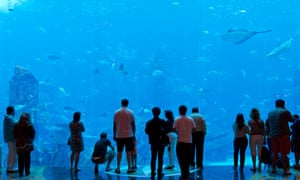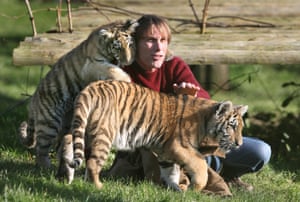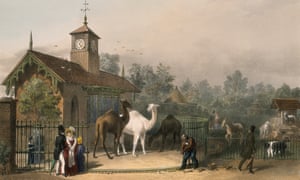Is it time to shut down the zoos?
by Robin McKie Sun 2 Feb 2020 08.30 GMT
Concluding with a comment by Dr Christina Nellist of Pan Orthodox Concern For Animals.
Cruel or kind? Education and conservation are cited as reasons for keeping wild animals in captivity, but many critics say zoos are outdated relics of a less enlightened era. We hear what both sides say
In a few days, a pair of two-year-old cheetahs, Saba and Nairo, will depart from the UK on a remarkable journey. The brothers will be taken from Howletts Wild Animal Park, in Kent, and flown to South Africa to begin a new life – in the wild.
It will be the first time that cheetahs born in captivity have left the UK for rewilding in Africa, says Damian Aspinall, who runs Howletts. “There are only about 7,000 cheetahs left on the planet and they are listed as vulnerable,” he says. “This reintroduction – to a reserve in Mount Camdeboo, in south of the country – is important because it will help to support the small population of cheetahs we have left in the wild.”
And the process of releasing animals from his wildlife parks is likely to continue unabated, adds Aspinall. He now campaigns vigorously for a sharp acceleration in the return of all captive animals to the wild and, ultimately, the closure of all zoos and wildlife parks in the UK – including his own.
“We have no moral right as a species to let animals suffer just because we are curious about them,” he says.
The day of the zoo is over, he claims – and his views are reflected by other critics who view wildlife parks andanimalcollections as anachronisms that should be phased out of existence over the coming 25 years.
Yet zoos are a major part of British culture. About 30 million visits are made to animal collections every year, according to the British and Irish Association of Zoos and Aquariums. Some of these outfits are small and isolated – and occasionally fall foul of local authorities for their mistreatment of animals. On the other hand, some larger institutions, such as London or Chester zoos – are well-run and, according to supporters, justify their existence for three clear reasons: education, research and conservation.
According to this argument, revealing the wonders of our planet’s wildlife to the public, and investigating the biology of these animals in order to help them return to nature provide zoos with valid reason to exist. In a world beset by climate change, habitat loss and soaring human numbers, zoos provide protection for the world’s endangered species.

So who is right? Is there any justification, today, for keeping wild animals in captivity? Are zoos good for the planet’s threatened creatures – or are they relics of past cruel attitudes to wildlife?
One argument is that zoos educate visitors, particularly younger ones, about the wonders of the planet’s wildlife. But Chris Draper of Born Free, the international charity that campaigns against keeping wild animals in captivity, disagrees. “Today, people get more from a TV nature documentary than they will ever get from seeing animals in zoos. In captivity, an elephant or a giraffe is out of its natural environment and probably in an unnatural social grouping. Television or the internet are much better resources for understanding animals than a zoo.”
Aspinall agrees. “David Attenborough’s programmes are far more educational than a day trip to a zoo,” he says. And you can see their point. Attenborough’s last series, Seven Worlds, One Planet, was made up of typically stunning material – dramatic close-ups of gentoo penguins fleeing leopard seals, pumas in pursuit of guanacos, and Barbary macaques in high-level chases after infant kidnappers. It was exhilarating, informative – and surely ideal for getting people hooked on animals.
But Attenborough flatly disagrees and is emphatic that his documentaries cannot compare to seeing the real thing. Only the sight of a creature in the flesh can give us a true understanding of its nature, he says.
“There is no way you can appreciate the quiddity of an elephant except by seeing one at close quarters,” he told the Observer. “People ought to be able to see what an animal looks like. And smells like. And sounds like. I think that is quite important. Actually, very important.”
Education certainly justifies a well-run zoo’s existence, he insists. On the other hand, Attenborough acknowledges that some animals fare better than others in zoos. “Modern aquariums are particularly successful, with their vast ceiling-high tanks in which you can see whole communities of different species of fish living together. They are absolutely fabulous.”
By contrast, polar bears, big raptors and large hunting mammals like lions are not suitable for being kept in zoos, says Attenborough. “I certainly agree with Mr Aspinall in saying you should not have lions in zoos – unless they were becoming endangered in the wild, which, of course is now becoming a real risk.”

And the same goes for conservation, he adds. “Breeding programmes for animals that are on the verge of extinction are of incredible importance. If it was not for zoos, there would be no Arabian oryx left in the world, for example.”
The Arabian oryx was hunted to extinction in the wild by 1972 but was later reintroduced – originally with animals from San Diego safari park – to Oman. Further reintroductions have since taken place in Saudi Arabia and Israel. It is estimated that there are now more than 1,000 Arabian Oryx in the wild.
Other species reintroduced to the wild using zoo-bred animals include the European bison and Przewalski’s horse. But that is about it, argues Aspinall. “Only a very small number of animals held by European zoos have been the subject of release projects, and third of those species were not rated as threatened,” he says. Instead, zoos are cluttered with unthreatened species put there purely to entertain the public: otters and meerkats are common examples.
However, zoo officials reject the idea that their rewilding successes are limited and point to other examples of successfully returning zoo-bred animals to the wild – for example, the Mauritius kestrel. In 1974 only four of these beautiful raptors were known to exist in the wild. It had become the world’s rarest bird thanks to habitat loss, introduction of non-native predators, and widespread use of DDT and other pesticides on the island.
A rescue plan was launched by a number of organisations, including the Durrell wildlife park and London Zoo, in a bid to save the Mauritius kestrel from extinction in the wild. “The invasive crab-eating macaque was a particular problem,” says Gary Ward, curator of birds at London Zoo. “It had arrived in Mauritius from Asia and was stealing eggs from kestrel nests. So we designed nesting boxes that were longer than a macaque’s arm, so they couldn’t reach in to snatch eggs. The birds then had a safe place to bring up their young.”
Nesting boxes, in combination with other conservation measures, allowed numbers of Mauritius kestrels to rise to about 800 – although these have dipped slightly in recent years.
Other zoo-led rewilding successes have ranged from the spectacular, such as the Californian condor which was restored to the skies above the western US last century, thanks to the release of young birds bred in San Diego – to the minuscule, such as the return of the tiny partula snail, native to Huahine and Moorea in the Society Islands, French Polynesia, from populations bred in London, Edinburgh, Chester and Amsterdam zoos.
However, zoo opponents argue that these reintroductions remain infrequent and do not justify the keeping of other, unthreatened wild animals, a point taken up by Sam Threadgill of Freedom for Animals, which has campaigned for the abolition of zoos for several decades.
Together with Born Free, Freedom for Animals has studied zoos in England and Wales and concluded that only a small percentage of their animals are endangered species, and only about 15% are threatened.
“It is a simple fact that the vast majority of animals kept in zoos are not endangered or threatened and are there simply to provide public entertainment,” he says.
Aspinall goes further. He maintains that many large mammals kept in zoos – lions, elephants, and rhinos, for example – are inbred or diseased or have the wrong genetic profiles to reintroduce to the wild, where they could further weaken wild populations already struggling to survive. “So why are they being ‘arked’ in the first place?” he asks.
The infrequency of releases of zoo-bred animals into the wild is acknowledged by Dominic Jermey, director general of the Zoological Society of London, but interpreted in a different way: “The truth is that many ‘wild’ areas are no longer viable habitats for animals – and reintroduction is much more complicated than people might realise. Many of the world’s most threatened species are living in habitats degraded by agriculture, threatened by disease or hemmed into tiny areas with no way of reaching potential mates without coming into conflict with humans.”
For his part, Aspinall points to conservation successes that he believes can be achieved with key endangered species without any input from zoos. First, he plans to gradually empty his two zoos – at Howletts and at Port Lympne, near Folkestone – and use these to help set up large groups of animals – gorillas, rhinos, lions and others – in protected reserves in Africa. “A particular animal would be given homes at several reserves so that if one got into trouble for some reason – civil war, for example – there would be other sources that could resupply the reserve once those troubles had been sorted.”
The majority of animals in zoos are not endangered or threatened and are there simply to provide public entertainment.Sam Threadgill, Freedom for Animals
Aspinall points to the example of the mountain gorilla. Their numbers had fallen to under 250 by the early 1980s. Today the population stands at 1,000. “This is in the country of Gabon, surrounded by aggressive habitat destruction, civil war and poaching – and all done without any captive breeding.”
The crucial point of this plan is that animals would not be kept behind bars but left to roam in their homeland. And instead of money being spent on zoos, funds would go directly to conservation.
But the idea of closing zoos to boost funds for conservation is challenged by Mark Pilgrim, chief executive of Chester Zoo. His organisation has a total annual budget of £47m.
“That money is raised virtually entirely from people paying at our doors to get in,” he says. “After you deduct our running costs and cash for new development, we have around £1.5m and that goes on conservation in the field – work that includes studies of chimpanzees in Nigeria and sun bears in Asia and a programme to reintroduce eastern black rhinos to Uganda. If we simply closed our doors, as some people have suggested, our funding of these conservation projects would come to an immediate halt.”
He quotes as an example Nigeria’s Gashaka Gumti national park, which houses the last reserve of the highly endangered Nigerian-Cameroon chimpanzee. “Chimpanzees here live in forests that are less dense and drier than where other members of the species live in other parts of Africa,” says Andrew Moss, a lead conservation scientist at Chester. “Their diets are rich in insects, and we have found they are amazingly adept at making tools that are just right for getting a different type of insect.
“The crucial point is that if we had closed our gates at Chester, the research camp we support at Gashaka Gumti would have been badly hit and this crucial field work threatened.”
Nor is it merely money for conservation work that makes zoos important, say supporters. Expertise built up in zoos is also crucial. Over the past few years, wild vulture populations in India and Nepal have crashed from about 40 million to a few thousand because of the use of diclofenac, a livestock anti-inflammatory drug that is highly poisonous to vultures who eat their carcasses.
“We have been closely involved in conservation work, and our expertise in building aviaries on site to protect the last few vultures – and in treating sick animals – has been tremendously useful,” says Nic Masters, assistant director of wildlife health at London Zoo.
In the end, these efforts and other attempts at conservation may prove futile in a world challenged by climate change, habitat loss and swelling numbers of humans, as Draper argues. “Keeping alive a handful of the last of a sub-species starts to look like fool’s errand because this tiny population is destined either to a life in captivity in perpetuity or to extinction. Neither of those two options is particularly attractive in anyone’s book, I would say. The damage has been done.”
This view is contested by scientists who still believe there is time to save species and who argue, strenuously, that zoos have a role to play as arks for threatened wildlife. This idea is backed by primatologist Jane Goodall, whose pioneering studies of chimpanzees in the wild have revealed the complex lives led by humanity’s closest biological relatives.
“Groups who believe all zoos should be closed have not spent the time I have out in the wild,” she once said. “They haven’t seen the threats destroying chimpanzee habitat; they don’t understand what it’s like to watch a chimp struggle, wounded and lame from a wire snare. But I do.”
The first zoo
Until the early 19th century, collections of exotic animals were usually owned by kings and queens and were symbols of royal power. This changed with the establishment of the Zoological Society of London in Regent’s Park in 1828. This was the world’s first scientific zoo and was intended to be a collection of unusual beasts for scientific study.

The collection was eventually opened to the public in 1847. A couple of decades later, the music hall song Walking in the Zoo was made popular by Alfred Vance and is notable for first popularising, in Britain, the word “zoo” as a short form of “zoological gardens” in addition to the Americanism “O.K.” in the song’s chorus: “Walking in the Zoo, walking in the Zoo/The O.K. thing on Sunday is walking in the Zoo.”………………………..
Pan Orthodox Comment: What then is the answer? There are a few – very few- internationally renowned zoos that have a place in conservation but even their figures show that this is a minor part of their business. And that is the point – they are businesses. Animals are kept in unnatural settings and zoos open to the public in order to make money for their owners.
Anyone who has lived and travelled in other parts of the world will know that the type of zoo exemplified by London, is far from the norm. The majority of zoos have no conservation programs and many keep animals in appalling conditions. See this recent post on our website of a wolf in Turkey. https://www.facebook.com/panorthodoxconfernforanimals.org/posts/635430197226225comment_id=635455320557046¬if_id=1580668600972722¬if_t=feed_comment
Even in the UK, the majority of zoos are merely entertainment institutions for the masses – somewhere to entertain the children. We have observed over the past decades that many have fallen short on animal welfare/public protection standards, which only come to light by whistle-blowers or concerned members of the public contacting authorities.
We believe that it is time for the local zoo to follow wild-animal circuses into oblivion, leaving a few specialist zoos to continue with endangered species conservation programs with the caveat that they must a) prove the need for their work and b) includes a program for returning animals into the wild.
